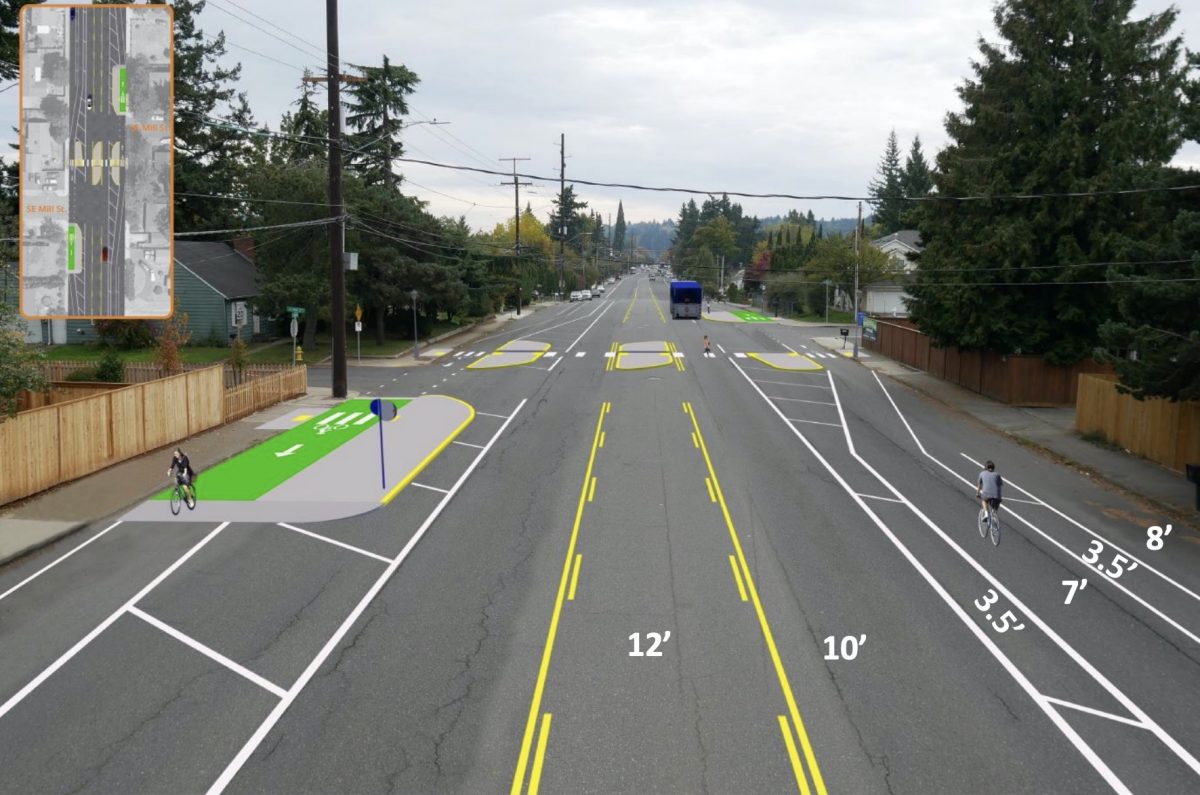
(Source: PBOT)
Portland’s plans for Southeast 162nd Avenue call for a road diet, but for bicycle riders the project will be more of a road buffet. With a $6 million budget the Portland Bureau of Transportation plans to re-configure the street in a way that reduces space for driving and vastly increases the space for cycling.
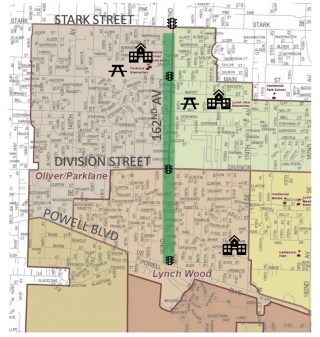
(Source: PBOT)
162nd between Stark and Powell (about 1.6 miles) is currently a typical east Portland arterial with on-street parking on both sides, a narrow and unprotected bike lane, and five general travel lanes (two in each direction and a center turn lane). The new cross-section will have three general travel lanes, with the extra space going to the bike lanes. PBOT is making the changes to complement a recent TriMet bus service upgrade on the street. In addition to the new striping plan, they’ll build seven new crossings (including substantial ones at Mill, Lincoln, and Tibbets), upgrade bus stops, repave the section from Division to Powell (0.7 miles), and build a few new pieces of sidewalk.
PBOT estimates that the change from five general lanes to three will lead to 68 additional seconds of travel time for the average driver.
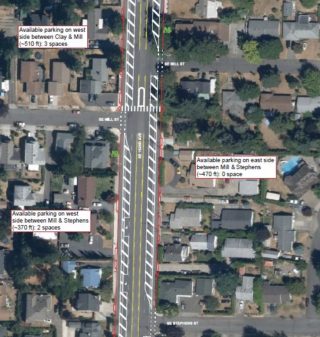
According to project manager Liz Rickles, who briefed the PBOT Bicycle Advisory Committee on the project at their November 10th meeting, initial plans called for a parking-protected bike lane where bicycle riders are curbside and people can park cars in the street. But Rickles gave a variety of reasons for why they’ve decided against that design. Chief among them was how a parking-protected design would have removed too many on-street parking spaces. “The challenge here is that there are so many driveways, that to allow for visibility of the driveways most of the on-street parking would get eliminated,” Rickles explained to the committee. “So you end up with the single parked car floating in the sea of asphalt.”
Rickles added that streets where PBOT has installed parking-protected bike lanes — like N Rosa Parks and NE Glisan — have shorter blocks and more sidestreets where people could park instead. The parking-protected design was also estimated to be $200,000 more expensive due to the need for plastic bollards and more pavement grinding. Local resident feedback also favored the buffered bike lane design, Rickles said.
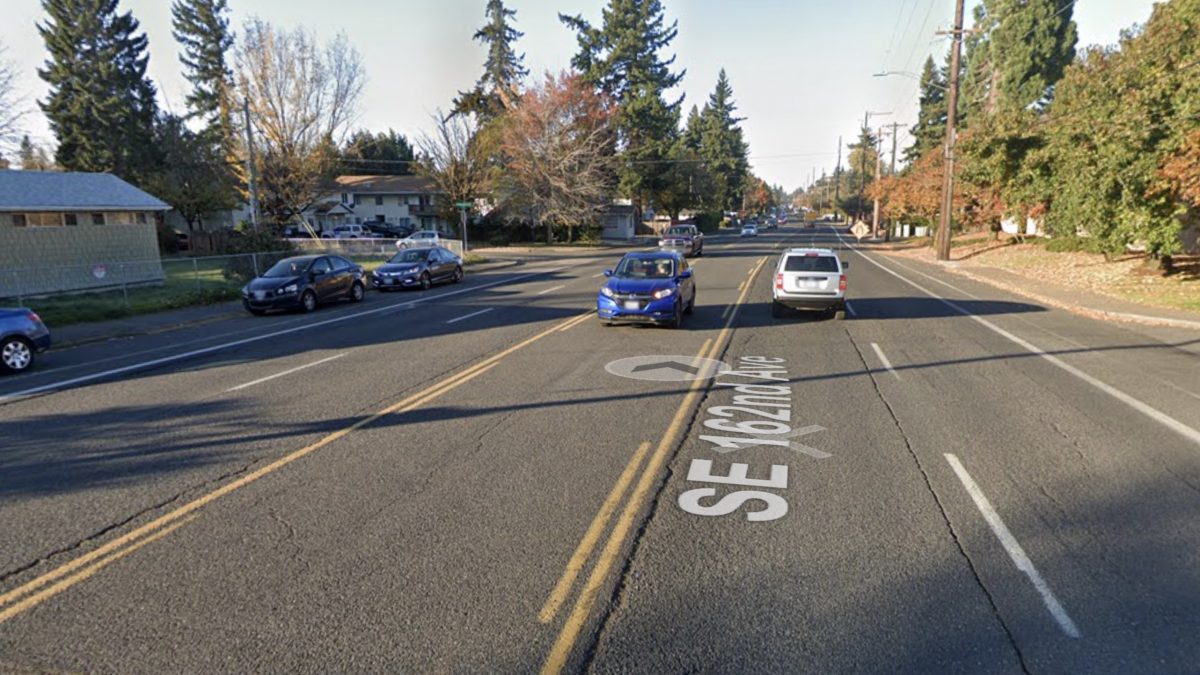

Advertisement
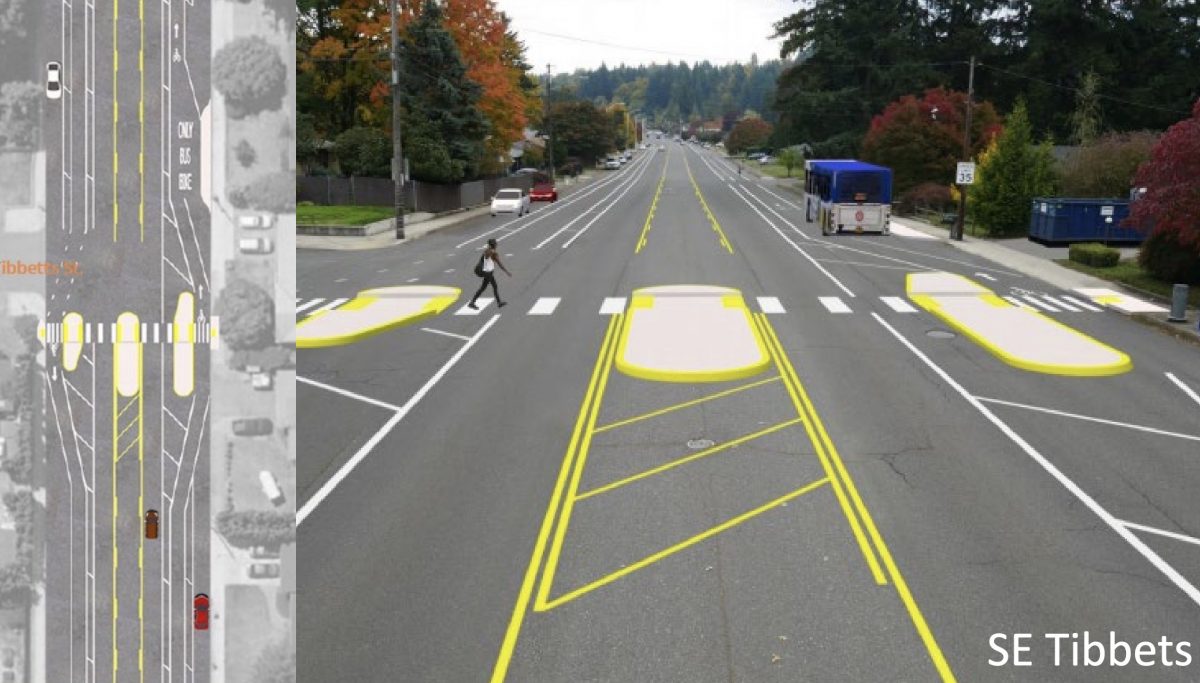
PBOT planner Zef Wagner, who was also at the meeting, reminded committee members that wider bike lanes were just a byproduct of the project’s main goal which was to make crossings safer on this dangerous street. 162nd is 76-feet wide and takes over 20 seconds for the average person to walk across. Combine that with a bad crash history and speed data that shows 80% of drivers go over the posted 35 mph speed limit (and 17% going 45 mph or more) and you see the need to tame auto users. “Doing a road diet was the way to provide crossings at an affordable price,” Wagner said.
If you’ve ridden the new bike lanes on North Denver Avenue in Kenton you’ll be familiar with this design. (It’s interesting to note that PBOT also initially proposed parking-protected bike lanes there too, and was going to implement them before they abruptly switched to buffered bike lanes due to pushback from nearby residents.) While wider, these buffered bike lanes offer no physical protection from car users. With the parking-protected design, bicycle users are separated from drivers by parked cars and concrete curbs and/or bollards.
One of the drawbacks of buffered bike lanes (opposed to curbside bike lanes) is that they weave back to the curb at intersections. With this project, PBOT will install bollards to help prevent right-hooks (see plan drawings below). Bicycle users will also share space with bus operators at some intersections (like SE Main and SE Division) where bus stops exist.
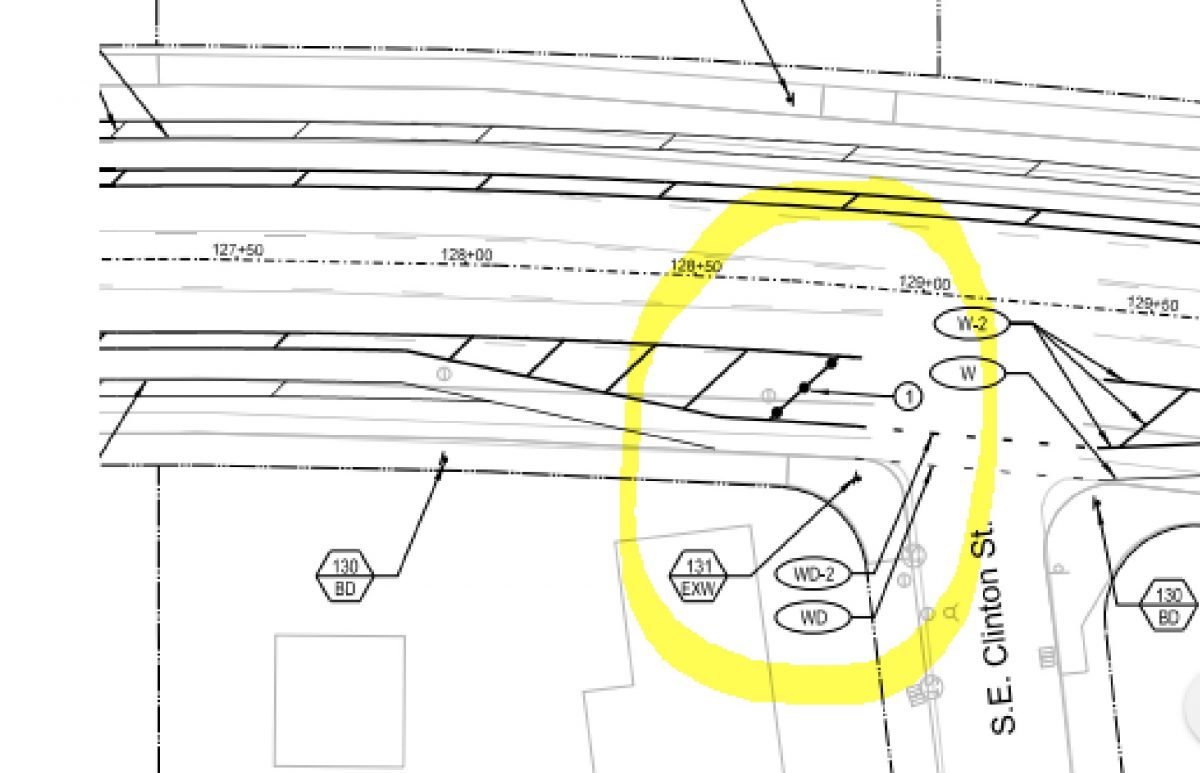
This project is slated to be built in summer of next year. For more information, check out the official project website.
— Jonathan Maus: (503) 706-8804, @jonathan_maus on Twitter and jonathan@bikeportland.org
— Get our headlines delivered to your inbox.
— Support this independent community media outlet with a one-time contribution or monthly subscription.





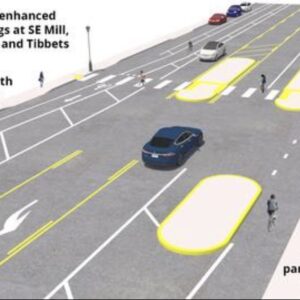

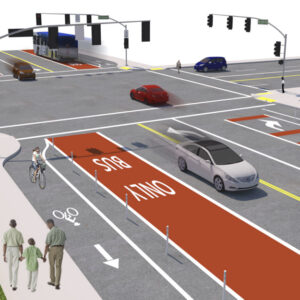

Thanks for reading.
BikePortland has served this community with independent community journalism since 2005. We rely on subscriptions from readers like you to survive. Your financial support is vital in keeping this valuable resource alive and well.
Please subscribe today to strengthen and expand our work.
Utterly baffling. We have standardized designs that are based on best practice and research. It’s as if we need to relearn and test lessons that have clearly been solved already.
And let’s be clear: In this case, by “we,” you mean Liz Rickles, who allegedly made the executive decision to prioritize parking spots over safety.
And her PBOT bosses who signed off on that decision.
I am glad that PBOT chose buffered lanes instead of parking protected, the problem I have with parking protected lanes in east portland is that they never get cleaned, I think that 162nd also needs speed/red light cameras.
That is a problem with policy, not design.
They also block the view of a cyclist leading to a greater risk of a right hook once the intersection is reached. I’ve been hit by cars twice on Multnomah entering the Keiser parking lot because of this. I’m so glad the scrapped the parking protected design.
Sorry to hear. Hope you’re ok. I’ve had my runins as well. Multnomah has no parking protection at Kaiser. Multnomah is also a very poorly designed street with intermittent physical barriers (eg planters) and no protected intersections (which are the most important part of a PBL). While blocked views can happen with poorly designed PBLs, the standard is this at intersections, which prevents right hooks.
The problem is allowing dangerous behavior by design. You would think that cyclists were the ones needing to be slowed based on the amount of meandering proposed for the bike lane! 162nd is not an “important emergency transportation route” which is the standard excuse to not slow down auto traffic: why not have the full travel lanes wander around instead of the bike lanes?
https://gis-pdx.opendata.arcgis.com/datasets/5f4369f08f344e2491cceaf0d6432cdc_181?geometry=-122.523%2C45.519%2C-122.475%2C45.530
I guess it’s better than nothing. Paint is not protection and this project won’t do anything to change the downward trajectory of cycling in Portland, but it’s better than narrow lanes with a single line of paint.
I also hate that PBOT has institutionalized the concept of “neighborhoods” (read: property owners) deciding how safe the roads near their property are going to be. If PBOT thought parking protected bike lanes were the way to go, they should do that. When they are doing a freight expansion or road expansion they certainly don’t let property owners dictate the design.
I too listened in on this meeting. The issue wasn’t so much as homeowners pushing back on parking-protected bike lanes as JM has presented, but that no one would actually park in the designated parking-marked areas. Either local residents would not use them (as for many of the East Portland main streets, 162nd has very few people parking in the street right now as it is) and thus bicyclists would no cars protecting them, or more likely, area homeowners would park illegally in the bike lane, knowing full well that there would be absolutely no enforcement.
This is just one situation. Another is when they made N Denver less safe because property owners didn’t want to walk as far to put out their trash bins.
Sometimes it works the other way though. N Willamette on the bluff was a disaster as far as green ways go with cut through traffic speeding down the street all morning. Cyclist complained for years and got nowhere. It wasn’t until the property owners got sick of the congestion near Greeley that PBOT was willing to do something about the cut through traffic
I’m not sure why on those rare occasions when PBOT actually listens to people, they get guff. Think of “neighborhoods” as directly impacted stakeholders and people who know the situation better than anyone else (a concept from state law, not PBOT). See David’s comment above about what PBOT learned when they listened; as a result the project will be more safe, not less.
“Neighborhoods” is longhand for us.
Huh? PBOT makes bike infrastructure less safe all the time to accommodate property owner concerns. They didn’t decide it would be less safe. The property owners conjectured it would be less safe. “Parking protected” bike lanes would have a bigger buffer than buffered bike lanes do, even without cars in them. I certainly feel better riding down Rosa Parks in the parking protected bike lane than I do in any buffered lane anywhere in the city.
And no, “neighborhoods” is not longhand for us. It’s shorthand for the NIMBYs who have the time to show up and complain and the NIMBY associations that try and block any safety project.
Finally, roads effect us all. I shouldn’t have to ride down unsafe bike lanes just because the people who happen to live along the corridor don’t value biking. We need a complete infrastructure system, not pockets of safety in neighborhoods that approve.
In this case, it’s shorthand for whoever wants to provide input during a meeting. That could be me, you, or anyone else who does or does not live in the neighborhood. Almost every neighborhood meeting I’ve ever attended has been open to everyone, and everyone could participate.
“Neighborhoods” have no special powers that you or I don’t have, and for projects like this, they don’t “approve” projects, and their forums are just places to gather more public input. If you find those meetings too challenging, you can write a letter to the planners, which would likely carry more weight than verbal comments heard in a forum.
My advice is to participate* instead of complaining about those who did.
*Had I participated, which I didn’t, I would have advocated for not having parking protected bike lanes, as I think they’re more dangerous than buffered lanes, introducing real threats while addressing theoretical ones.
Hey Hello, Kitty, I understand you still don’t like PBLs despite the overwhelming evidence they are safer. Here is yet more evidence.
Thank you! I tried going to the source article, which is, sadly, behind a paywall, and while the abstract does not mention protected bike lanes, it does say this:
I would love to know if there is a causal relationship between parking protected bike lanes and injuries, or whether it is that cities with more cyclists are inherently safer (as the abstract states), but because there are many cyclists they are also more likely to build protected facilities which, themselves, confer little benefit. I also wanted to look for a comparison with buffered bike lanes; the article you directly referenced mentioned only about shared and conventional bike lanes. Perhaps the paper contains more data. In any event, the operative mechanism seems to be slower driving speeds. Perhaps putting parked cars closer to moving ones slows drivers?
If there are convincing findings that parking-protected bike lanes are safer than buffered bike lanes, I will support them in the future where safety is a primary factor, as it often is. I know you think me dogmatic (kittymatic?) and rigid, but I do change my positions based on evidence.
Great to hear you are examining the evidence! I hope others follow in your footsteps.
That’s not the case. There are lots of people who can’t attend these meetings for various reasons including they work during them, they need to take care of their children, they can’t get to them, etc..
Ha, no, as someone who has written hundreds of emails to PBOT they care just as little about letters from cycling advocates as they do public testimony. I’m not sure why you are fixating on the meetings. The reality is that PBOT doesn’t care about anyone who doesn’t own the property on the corridor. They could hold zero meetings or hundred but the NIMBY property owners complaints are going to carry more weight for PBOT than a thousand cycling advocates. Especially if the complaints are coming from the local NIMBY association.
Haha, that’s cute. You think participation drives PBOT/ODOT/Metro decision making? Does the Rose Quarter sound familiar to you? If we are just going off the view points of the people who participate, the Rose Quarter would have been scrapped five years ago. PBOT/ODOT/Metro do not care about my opinion.
It’s also comical for you to advocate for a system where the citizenry has to travel all across town in order to badger the local transportation agency into making safe and equitable infrastructure. This “infrastructure by committee” is a waste of time and money. PBOT knows what the evidence says. They need to implement evidence-based infrastructure at every project they do regardless of NIMBYs clutching pearls.
This is in Centennial, the second largest neighborhood (out of 95) in the City of Portland with over 25,000 residents, and among the poorest and most racially diverse BIPOC neighborhoods in the city. 162nd is the main north-south street through the neighborhood (148th is on the western edge of the neighborhood.) I’m sorry to see someone on BP use the term NIMBY in association with such a neighborhood as poor as this.
There’s a lot going on in this post; I’m going to break out the assertions to make them easier to examine.
I was going to try to rebut these, but I think this list speaks for itself.
You talked about what I want: I support a system in which the public has meaningful input into proposed infrastructure projects. Neighborhood Associations simply provide a way for people who are organized around a particular geography to discuss issues and, when appropriate, take collective action, which usually consists of the same things that any of us can do (with small number of exceptions mentioned by matchupancakes below), which is mostly just writing letters. They are, in short, a talking shop.
I believe the reason that some people, such as yourself, do not like NAs is that they provide a forum where people with whom you disagree with can express themselves (and I suspect that if you spent any time with them you’d find that you agreed with most NA members on most issues most of the time). There is absolutely nothing inherent in their structure that prohibits you from using NA meetings to express yourself just as your neighbors do. And nothing is prohibiting you from creating your own alternate association of neighbors, though it is interesting that when others have done this, they are rarely as open or as democratic as NAs are.
Finally, I’ll say that in the scores of communications I’ve had with PBOT staff over the years, I was never asked once whether or not I owned property. While it is possible they did some research on me, I suspect your fears that Eudaly’s bureau only considers the views of property owners is simply wrong.
It’s okay Hello, Kitty. I know you live in a different Portland than most people. You live close in and think biking is actually really nice in this town. I get it, you’re hyper privileged and it’s hard for you to see how other people interact with the government.
NIMBY associations, just like the Homeowners Associations they mirror, do not represent the community.You like NIMBY associations because you have the time and ability to attend meetings and they make you feel heards. I get it. Most people don’t have that access. I’m not entirely sure why you think I don’t attend NA meetings though? I know that you like to make things up to fit your narrative, but unfortunately you are wrong about that one as you are about most.
And yes, the city of Portland does not care about public comment from anyone who doesn’t own property on the corridor. You’d know that if you paid attention but in your bizzaro Portland the city apparently never listens to homeowners and always implements exactly what safety advocates want.
A lot of misinformation there, but you keep bringing up the notion that because some people have conflicting schedules, NAs are somehow illegitimate or are inherently unfair.
Are there better ways for PBOT to talk to residents about a project that will affect them than coming to their community in an established forum at a scheduled time and discussing the project with everyone who comes? I know PBOT (and other bureaus) are looking for additional ways to reach the public, and if you had a better mechanism than presenting to civic groups focused on the project area, I’m sure they’d be receptive.
But absent a better idea, it sound like you just want greater barriers to regular folks giving their opinion because you disagree with what they might say. Which reminds me of a certain political party that has been in the news lately.
The core problem with NAs is that ten or so random, unelected people don’t represent the opinions of the tens of thousands people who live in a neighborhood.
One fair way to gauge public support would be to conduct a poll of everyone who lives in the neighborhood/city. Seville did this to gauge whether there was interest in building a protected bike lane network, and 90% answered yes: https://usa.streetsblog.org/2018/05/07/six-secrets-from-the-planner-of-sevillas-lightning-bike-network/
You are right that NAs don’t represent everyone in the neighborhood, and while a few still claim to, they shouldn’t. They do form a nucleus around which people can engage civically, learn about the city, and work with their neighbors on projects of common interest. As such, they offer a good venue for bureaus who are trying to get the word out.
For someone normally so skeptical, it’s weird how you seem to eagerly drink the Kool-Aid of what NAs purport to be.
That’s only what they are in theory—in reality, they’re all just a dozen or so people who claim to represent the neighborhood and love to complain about stuff.
And how is this different from the people we vote for elected offices? If I didn’t vote for the person elected, why should I be governed by them?
Whether you or I like it or not, we live in participatory democracy. If we don’t participate, be it by voting for elected officials, being appointed to a government advisory commission like the BAC, or by working with a neighborhood association, we not only lose out in having any sort of voice in our democracy, but we also fail the public good by publicly complaining but not participating when we do have opportunities to do so. We end up being like JM, a journalist, poor thing.
I’ve probably attended meetings in 8 or 9 NAs, and your description does not reflect anything I’ve seen. However there are 95 different NAs, and in any group that big that are bound to be a few duds.
All it takes are 10 well politically well connected people or social influencers to make more noise than the 10,000 people who are for bicycle improvements, such as half the commenters on here, and their opinions will dominate the public comments period for public works.
You can call it whatever you like. NIMBY associations inherently represent the people who have the time and interest to attend them. Just like homeowners associations. Lot’s of people have thoughts who can’t attend or don’t want to attend those meetings for various meetings. My local NA is toxic as hell and I don’t blame anyone for not attending the meetings. My main point is that they in no way represent the community as if they are some random sample. It’s inherently a self-selected, usually privileged group.
Receptive to feedback is not a characteristic I’d ever attribute to PBOT or anyone who works there. They like NAs because after they’ve modified a project to please the NA, they are good to go. They have officially “engaged” the community and continue onto whatever paving project they want to do.
I already told you. PBOT should build evidence-based infrastructure and completely get rid of this “infrastructure by committee” nonsense. Community input on safety projects is almost always total garbage. “Regular folks” don’t attend these meetingss
Any project involves a series of tradeoffs of one thing against the other. Weighing this vs that is an inherently political process, and is not something that can be done scientifically or based on data.
Inherent in your comment is a values statement that safety should be the only design consideration, and any deviation from “the safest” is a victory by NIMBY activists (everyone else) over the righteous (you). But safety is never the only consideration. If it were, we’d just close the street altogether. And in this case, PBOT learned that their initial design would likely be misused, creating a more dangerous situation than their final plan, so it’s probably good that they listened.
We probably just disagree over whether the public should have a voice in the design of public infrastructure. I am almost always in favor of more democracy, even when I don’t like the outcomes, because that’s just how it goes sometimes when you live in a complex society where people hold a variety of views. I know that there are plenty here who disagree, and would favor a bit more dictatorship as long as the dictator was doing what they wanted. That sounds like you, but it’s just not how I roll.
That’s not entirely accurate. Neighborhoods have the option to appeal development applications (and before Oregon LUBA if necessary) and require developers to present to the neighborhood association before the Bureau of Development Services makes a decision on the application. You and I certainly could write letters to BDS encouraing the same but we can’t compel developers to present proposals before us.
These “powers” have nothing to do with the PBOT allegedly prostrating themselves before property owners when it comes to installing bike lanes.
Yes, NAs can have an administrative appeal fee waived (anyone can appeal a decision all the way to LUBA). You are also right that you and I cannot compel a developer to come to our house and present to us, but we can attend the public meeting where the developers are presenting to residents, which is, on a practical level, the same thing. Following that meeting you can have the same level of input into a decision as an NA does. Even in the realm of landuse (which is where NAs arose), they really are very limited.
But this all has no relevance to the contention that NAs have some magical sway over transportation infrastructure.
Here is a clear example of the stars aligning: PBoT has the money, no one seems to be losing “their” parking spot, and no drivers appear to think the reduction in capacity will slow them down. PBoT has nothing preventing them from hitting this teed up wiffle ball. So given a best case scenario, when they are unhindered to build the safest, gold standard design, PBoT still delivers mediocre.
JM’s write-up says that a parking protected bike lane would have resulted in significant loss of parking because of all the sight-line setbacks required because of frequent driveways…
My mistake. The loss of parking is precluding safe design.
PDX is likely at the tipping point where demographics and mode share declines have evaporated the political impetus for major cycling improvements.
If someone genuinely values active transportation and is able to move, I’d recommend moving to a region (or nations) that better value non-motorized transport.
I’m afraid to tell you this, but you are already there. I live in NC and I can easily tell you the southeast (Deep South) values motorized traffic at 90% of all transportation funding, rail and transit 5%, all other modes including airports, shipping, scooters, bike, and ped, the remaining 5%.
Another PBOT project that no one will use. I have yet to see a single cyclist on the redone portion of outer Glisan, and this is likely to be more of the same. Plus more ridiculous experimental designs, that seems to be the standard MO at PBOT now.
Bike networks that don’t connect people to places they want or may need to go to are never going to have many users. But once the full network is up and running, connecting local greenways to arterial bikeways and local businesses, schools, and institutions, then you’ll see much more use. This project connects Powell Butte (& outer Powell Blvd) to the not-yet-implemented improvements on Stark, but it’s all residential in between. However, the road diet is badly needed, to connect students on the west side to the school on the east side.
Stay tuned, full network up and running by 2200!
Nonsense. It will be up and running by the next city rankings by Bicycling Magazine and by People For Bikes, the yardstick of all gold standards.
The “meander” of the bike lane back toward the curb at intersections actually is a significant and important safety feature. This puts bicyclists within the driver’s cone of vision rather than keeping them in a blind spot or expecting drivers to turn more fully to look over their shoulder for bicyclists (unlikely). It’s a minor inconvenience with clear benefit and is certainly best practice.
Very exciting for Powell Butte trips!
So many other updates regarding bike lane and other cycling/pedestrian infrastructure projects have comments of people lamenting the lack of PBOT action in east Portland, yet here is a project in east Portland and so far there is only one comment that is straightforwardly positive about this. I’ll check back later and hope to see all the folks complaining about east Portland being neglected chime in.
Hey Ricky, I understand it’s difficult to see bike infrastructure in E Portland criticized. I’ve wished for changes to this and other streets near here for most of my life. In reality, something is better than nothing often enough. But in almost all cases PBoT is prioritizing parking and car capacity over the gold standard design supported by decades of data. Just a few people storing their private property is preventing families from having a safe route, and ensuring people will be injured/killed due to faulty design for years to come. So I’m happy something is finally happening, and I’m disheartened by how a few people with cars can continue to preclude a safe place.
I think the general trajectory of this project is moving us in the right direction: calming traffic, disarming opportunities for traffic violence, promoting alternatives to automobiles, increasing bike/ped safety, etc. We need even more investments like this in east Portland, beyond what is currently funded under the Fix our Streets program https://www.portlandoregon.gov/transportation/64188.
But as with all/most of its traffic safety improvements, PBOT is too focused on the proximate and immediate harm, and neglects or downright misses opportunities to integrate green infrastructure like trees and green streets to address the climate crisis. We are not breaking up the large expanses of pavement to slow traffic and remedy urban heat sinks. We could easily get a two-fer here and probably reduce our reliance on energy-intensive concrete in the process. But the siloed PBOT thinking is only about the immediate traffic safety and not the long-term harm caused by their paving, paving, and yet more paving.
More people die from extreme heat globally than all other natural disasters combined. What is it going to take to get PBOT to consider this in their design work?
I would like to see a plan to keep these types of bike paths cleaner..I avoid these major street even with good bike infrastructure do to the shear amount to tire deflating debris that get pushed into the bike lanes.
The Springwater trail is also on my list to avoid for the above reason and more..
Will stick to finding my ways thru neighborhood street..
To parking-protected bike lane fans, do you really want to get relegated to the dirtiest, wettest, most glass-littered, mud-filled and leaf-slimed part of the road up against the curb? We know a PBL will virtually never be cleaned. Especially not on 162nd . . . no, that’s not fair, but I think it is true.
By “fans” do you mean people who understand what has now been standard design in most European countries for decades can also work here? Remember, this design isn’t just for you. When you argue against gold standard/safe design, you make it harder for families and people who would normally not bike.
They DONT work here because our culture is different. I wish they did but they don’t. We need our own ideas and solutions that work with the way our population uses (and abuses) their vehicular privileges.
They work in NYC, Vancouver BC., Seattle, Montreal, SF, DC… Here’s a list. Just not in Portland?
It’s not about our culture, it’s about our crappy design and maintenance standards, neither of which come anywhere close to the European ideal. You can’t just say ‘well this is the gold standard’ and then build any old crap, meanwhile failing to repave or fix the drainage, and then ignoring the maintenance.
Parking protected bike lanes are definitely not the “gold standard” in Europe. https://usa.streetsblog.org/2019/12/03/a-bill-of-goods-why-are-we-putting-up-with-parking-protected-bike-lanes/
I also don’t think “X is the gold standard in Europe” is a good answer to any question. We should build things that work for the conditions here – physical, financial, social.
Yep. Protected bike lanes are standard. True, local conditions matter.
That article outlines almost all the reasons why I think parking protected bike lanes are dangerous.
This isn’t enough. With no enforcement you’ll have another mess like NE 102nd. I’ve seen speeding drivers get impatient and pass other cars using the bike lanes. Thanks Hardesty.
My recollection is that the great majority of bicycle/car accidents are at intersections, with dooring next. Of the dozens of bicycle/car accidents reported on BP over the past decades, I cannot remember any where a car departing the traffic lane struck a cyclist who was riding straight in a marked bike lane. Maybe there were a couple but I sure don’t think it is more than a rarity.
Given that, I think the “what kind of bike lane” debate is mostly a distraction. Make it wide enough and buffered (not door zone) and focus on where bike-car accidents actually happen. Safer intersections will also save pedestrian lives, which are taken far more often than cyclist lives.
On a street like 162nd, perhaps curb bump-outs and refuge islands should be used at every intersection to narrow lanes, slow drivers, allow pedestrians to cross more safely, force cars to make sharp, wide, and thus slower turns into side streets, and ensure clear visibility of cyclists as they approach the intersection. Combine with really good lighting and on-demand signals, with signage and aggressive camera enforcement.
For these blocks of 162nd, if budget is not a constraint then ideally we’d extend the sidewalk by 6′ to be a grade separated bike lane AND make the intersection improvements. If we can’t afford both, then I’d personally take the intersection improvements.
You are nearly correct, or at least getting closer. Most injury crashes occur at intersections. Most fatalities actually occur at straight road sections or “non intersections.” Here and here are the sources. This is why PBLs (and protected intersections) are standard design. I can recall very vividly the result of someone driving up the bike lane behind me until I was on their hood.
I’ll admit I did not read through the second link, which is a 248 page tome about all sorts of traffic mayhem, but I did read the first, and I stipulate that it says what you say it says: 60% of bicycle fatalities occur between intersections. What the article did not say was what the cause of those fatalities was. If the primary agent was a car striking the rider from behind, then that would be a good argument in favor of parking protected bike lanes. However, if the causitive agent was being doored or crashing into a parked car (the report said 70% of injuries did not involve a driver), then a buffered bike lane might provide just as much protection, with the added benefit of not teeing cyclists up to be hooked at intersections or driveways, another danger the article noted.
What we really need is a study comparing buffered bike lanes with parking protected bike lanes that considers mechanisms of danger, possibilities of misuse (such as improper parking, placement of recycling bins, etc.), and maintenance such as sweeping, flooding, and leaf removal.
That might make a good thesis for an urban planning PhD candidate.
248! Come on who’s actually read every page? Ok how about graduating to a lit review? This’ll keep you busy for a weekend. We’ll all be deferring to you for design guidance.
What you seem to be completely missing is that most people simply don’t feel comfortable biking in unprotected lanes
162nd may not be an emergency route, but there are certainly some design constraints many of you may not be aware of, for example, several major water lines run under this street to and from the Powell Butte storage reserviors.
*Plastic bollard is an oxymoron. Take a look at Off Season Naito.
*Ted Labbe is right every single time he clocks in with his green space comment.
*We are all holding a different part of the moose (tired of elephants).
*With experience, bike users will ride the line with fewest conflicts and least trash, and no one else cares.
*Chronic lack of maintenance = deeply unserious bike ‘program’, lacking a better word.
*Fourteen feet apparently given to bikes is a frank invitation for MV operator chicanery. Yes I see the buried pun.